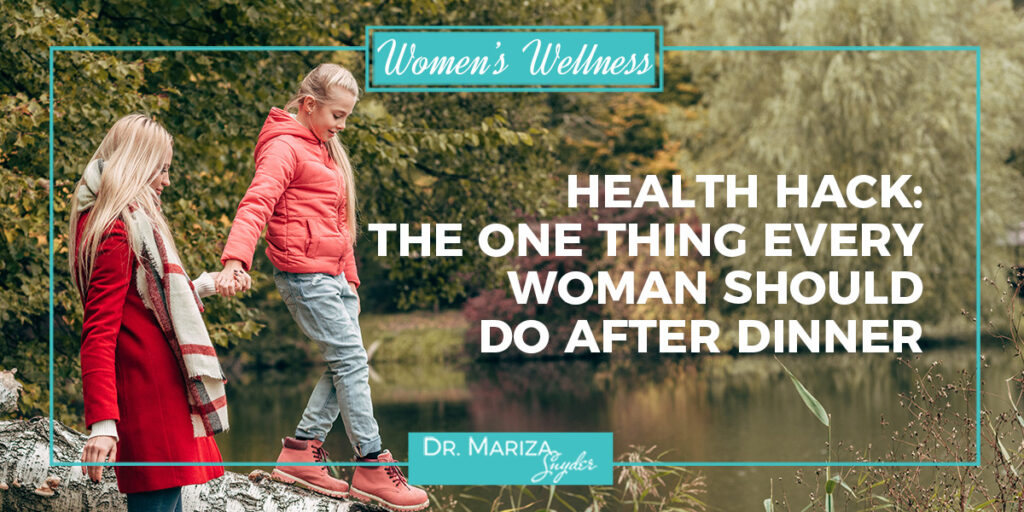
When you have a long day of work, running errands, or cleaning up at home, you may already be feeling tired by the time you’re done eating dinner. Not to mention the time and energy it takes to cook a meal and clean up afterward.
After eating dinner at the end of a long day, you essentially have two options:
The first one is one of the most satisfying things to do — curl up on the couch, turn on your favorite show and settle in for the night. (The show that I’m watching right now is “Succession.”)
The second option is walking it out for 20 to 30 minutes after dinner — 30 minutes being the most ideal. That’s 15 minutes each way — there and back.
Often, at the end of a long day, you just want to sit and relax. But I have a feeling you know which one extends your longevity.
HOW A WALK AFTER DINNER IMPROVES YOUR LONGEVITY
Hands down, I believe that walking after dinner is the best thing you can do for your metabolic health — and overall health. And guess what: There’s a ton of science to back it up!
We all know that walking itself is its own solid form of gentle exercise, but doing it after eating any meal does even more for your body, including:
- Boosting your metabolism
- Aiding digestion
- Lowering stress levels
There are a lot of benefits to walking after eating, also known as postprandial exercise:
- Lowers your glycemic index significantly
- Blunts a blood sugar response
- Reduces insulin resistance
- Improves your intestinal movement
- Promotes better sleep
- Boosts your blood flow
If your schedule allows you to schedule a short walk after every meal — or even your morning and dinner meals — that’s even better!
Here are the top five benefits that are so compelling that they will inspire you to start walking after meals — even if it’s just after breakfast.
#1 IMPROVED FASTING BLOOD SUGAR AND INSULIN SENSITIVITY
This is the benefit that I am most excited about, given there are hundreds of millions of people struggling
with metabolic dysfunction and blood sugar issues.
Because this is the biggest benefit, it’s great to know how much research backs it up.
Current evidence suggests that exercising in the “mid postprandial phase” of the feeding cycle (which tends to fall 30 to 120 minutes after eating) most effectively tames a glucose peak.
One 2016 study examined over three dozen papers with 615 total participants who had various metabolic conditions, including:
- Diabetes
- Prediabetes
- Obesity
The study also included people without any diagnosed conditions. The study concluded that exercising 30 minutes after eating is the ideal time to curb glucose levels.
WHY TIMING IS IMPORTANT FOR POST-MEAL WALKS AND BLOOD SUGAR
Exercise timing matters because of the mechanics of glucose uptake:
- When you eat, glucose enters your bloodstream from your gut, raising the blood sugar concentration.
- But when you exercise right away, that glucose is quickly taken up by muscle tissue, bringing your blood sugar levels back down.
- Your body’s glycemic balance depends on how quickly meal-derived glucose arrives in the blood and the rate at which exercise draws upon this fuel.
THE FOOD YOU EAT IS ALSO IMPORTANT WITH TIMING POST-MEAL EXERCISE
For the same reason that timing is crucial, the type of food you eat can also affect when you go on your post-meal walk.
A 2019 trial looked at the optimal window for exercise around eating a 500-calorie liquid meal, as liquids are absorbed by the body faster than solid food.
In the study, researchers examined the glucose response of 48 adults who performed 30 minutes of physical activity at various times before or after eating or did no exercise at all.
Moving immediately after the meal was the clear winner:
- Walking and bodyweight exercises improved glucose levels.
- Even standing upright after a meal offered a little benefit.
- Participants saw no impact on glucose exposure or variability when exercising before, 30 minutes after, or two hours after consumption.
If you’re having a fruit smoothie for breakfast or lunch or eating fast-absorbing carbohydrates — think fruit, starchy foods, or anything processed like foods containing sugar or refined flour — you may want to get moving right away.
BIGGEST TAKEAWAYS ON EXERCISING AFTER A MEAL AND GLUCOSE LEVELS
The evidence is clear: Whenever possible, move your body after eating.
Doing this helps mobilize post-meal glucose to fuel physical activity and curb the spike you might experience if you were inactive.
- Walking after eating — for 30 minutes within six hours of the meal — is a good standard for healthy people, though sooner is likely better.
- After finishing a meal, taking a brisk walk for about 30 minutes is an excellent habit to adopt. Alternatively, just walking briskly for a minute and a half every half hour has significant benefits on overall daily glucose and insulin levels.
- Set a timer for every half hour to remind yourself to get up for just a minute or two to move.
#2: IMPROVES DIGESTION
Once you’re done eating, your body starts working to break down all the different nutrients from your food in your gut.
Your body absorbs and transports…
- Proteins
- Electrolytes
- Water
- Vitamins
- Carbohydrates
- And other nutrients
…through your body and takes them wherever they’re needed.
This process can be improved by walking after eating, as walking has been found to play a significant role in reducing gastric emptying. This happens by reducing the time that food moves through the gastrointestinal tract, which results in faster digestion and less bloating after eating.
By moving your body, you’re helping things move within it as you process the food you just ate. This is especially helpful if you tend to get sluggish after a meal.
#3: DECREASES STRESS
We all know that exercising is one of the best ways to reduce stress. My personal favorite form of exercise to reduce stress and overwhelming feelings is walking or hiking in nature.
I have always found that my best ideas and creativity come to me when I am walking in nature because I am away from the day’s tasks, and my mind is clear and happy.
EXERCISE AND ENDORPHINS
When you exercise, your body releases endorphins — those amazing feel-good chemicals that create that natural high. As a side benefit, this significantly reduces the release of stress hormones and rewires the brain to reduce stress response patterns.
Walking and breathwork are the most powerful ways to move your way out of feeling stressed.
Whether you are taking a casual walk or a brisk walk after each meal, it helps produce and release the feel-good hormone: serotonin.
Serotonin is a neurotransmitter that:
- Promotes good sleep
- Helps regulate appetite
- Improves learning and memory
- Increases positive feelings
Even an easy, relaxing walk after a meal can help you reap the same calm-boosting benefits. Walking after meals creates a calming effect on the body, which can improve your mood, focus, and concentration. It’s not just good for your physical health — it’s great for your mental health, too.
#4: BOOSTS BLOOD FLOW
When you’re walking, you’re letting your body pump more blood throughout all its systems — which is especially beneficial after a meal.
Your muscles, brain, and heart are beyond grateful because blood flow to these organs is critical:
- Walking induces blood flow to the limbs and organs.
- Better circulation due to movement will result in a healthier vascular system.
- That will better transport the necessary nutrients to bones, muscles, and organs to work more efficiently.
#5: IMPROVED SLEEP
While you might be tempted to curl up and fall asleep after a big meal — and believe me, I often am — a short walk will actually help you sleep better at night.
Walking after eating promotes a faster and deeper sleep, as serotonin is a precursor to melatonin.
Taking the time to clock some steps after dinner in the evening sets your circadian rhythm up for success. It naturally boosts melatonin levels and helps your digestive system digest your food quicker, giving your body more time to reset for bed.
INCORPORATE POST-MEAL WALKS INTO YOUR DAILY ROUTINE
Now that you have my top five compelling benefits for adding 20 to 30 minutes of exercise after your meals, I recommend starting with one meal. Incorporate a post-meal walk to whichever meal is the easiest to add a walk to, even if it’s for just 10 to 15 minutes.
MY PERSONAL WALKING ROUTINE
I personally walk twice a day — in the morning before jumping into work and around sunset to watch it over the ocean next to the local beach. These are the easiest times for me to walk for 30 to 40 minutes.
I typically also work out in the morning before I break my fast and try to step outside and walk when I am on call. It’s always my goal to walk after dinner, but this sometimes depends on when dinner happens in my house.
FIT WALKS IN YOUR ROUTINE WHENEVER POSSIBLE
With a baby or a difficult schedule, sometimes it can be tricky to walk at the same time or incorporate post-meal exercise each day. That’s why my word for this year is surrender.
If you have a more consistent work and meal schedule, I invite you to adjust it a bit to fit in a walk after meals. If your schedule is not consistent, like mine, however, get it in where you can fit in.
Remember: The goal is to move your body as much as possible throughout the day.
NEAT ROUTINES
I am sure you have heard the phrase: “sitting is the new smoking.” Many of us sit at our desks a lot — day in and day out — contributing to a sluggish metabolism. The more we can remedy this daily, the better it is for our health.
This is why I love non-exercise activity thermogenesis, also known as NEAT. Non-exercise activity thermogenesis — or the energy expended from general daily activities — has a significant impact on the number of calories your body burns each day.
By moving more in your daily life, you’ll see huge improvements in your metabolism.
I invite you to look for more opportunities to move throughout the day. Some simple ways to get a bit more activity in your daily routine include:
- Park your car further from the entrance to your office.
- Take the stairs instead of the elevator.
- Walk around your house during a phone call.
- Do 20 squats during a three-minute work break.
The more you move, the more calories you’ll burn — and your overall mindset and metabolism will improve.
Let’s make 2022 the year we add in more walks and steps!
TRACK YOUR DAILY WALKS AND SHOW SOME SELF-CARE WITH A JOURNAL
If you’re ready to commit to adding more walks into your daily routine, one of the best ways to make it a habit is to journal about it.
With my Daily Self-Care Journal, you can show mindfulness and keep track of your daily post-meal walks. It’s a great way to track your progress and make it a daily habit
Show yourself some self-love & grab a Daily Self-Care Journal Today!

No comments yet.